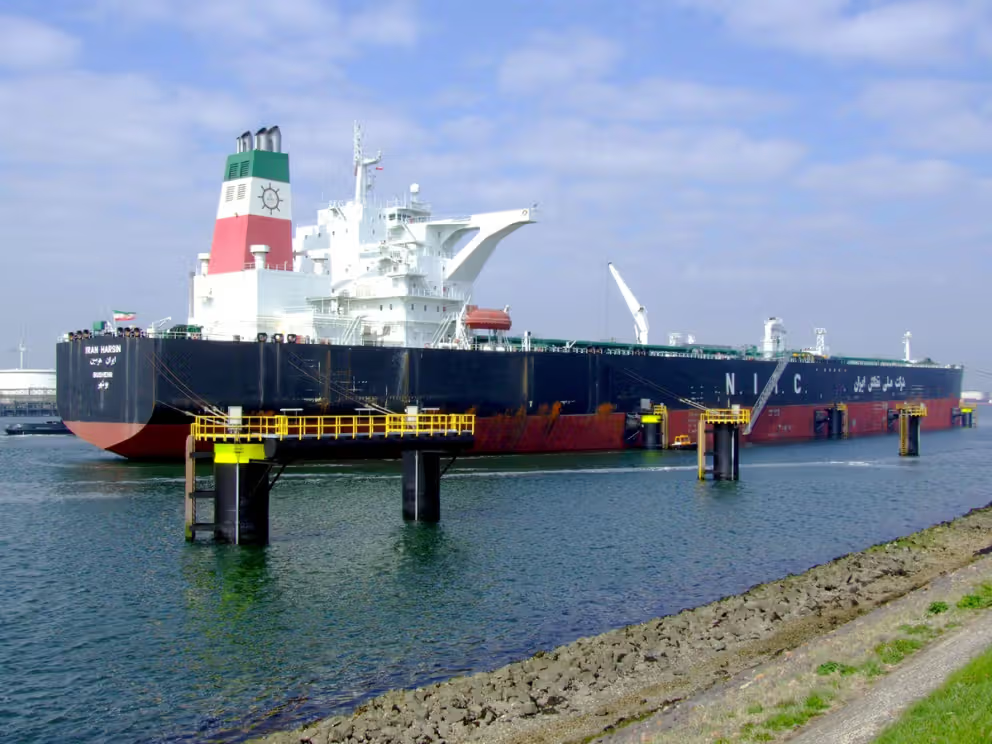Digital Siege at Sea: The Escalating Cyber War Against Iran's Maritime Empire

Executive Summary
In the digital age, warfare has expanded beyond traditional battlefields to encompass the invisible realm of cyberspace, where a single compromised computer system can paralyze entire fleets. The ongoing cyber campaign against Iran's maritime operations represents one of the most sophisticated and sustained digital sieges in modern history, revealing the critical vulnerabilities that lie at the intersection of geopolitics, economics, and cybersecurity. Through a series of coordinated attacks by the Iranian hacktivist group Lab-Dookhtegan, Iran's "shadow fleet" operations have faced unprecedented disruption, exposing the fragility of the digital infrastructure that underpins global maritime commerce.

This comprehensive analysis examines the multifaceted dimensions of this evolving cyber conflict, from the technical vulnerabilities in satellite communication systems to the geopolitical implications for global energy security. As Iran's maritime operations serve as the economic lifeline for a sanctioned regime, these cyberattacks represent more than mere digital disruption—they constitute a form of economic warfare that could reshape regional power dynamics and maritime security protocols worldwide.
The Theater of Operations: Iran's Maritime Network Under Siege
Scale and Sophistication of the Attacks
The cyber campaign against Iranian maritime operations has unfolded in waves of increasing sophistication and scale. The most recent attack in August 2025 targeted 64 vessels—39 tankers operated by the National Iranian Tanker Company (NITC) and 25 cargo ships belonging to the Islamic Republic of Iran Shipping Lines (IRISL). This followed an even larger March 2025 operation that affected 116 ships, demonstrating the attackers' ability to scale their operations and maintain persistent access to critical infrastructure.
The precision of these attacks is remarkable. Rather than employing broad-spectrum malware that might cause collateral damage, Lab-Dookhtegan has demonstrated surgical precision in targeting specific components of Iran's maritime communication infrastructure. By infiltrating Fanava Group—Iran's primary provider of satellite communications, data storage, and payment systems—the attackers gained access to what cybersecurity experts describe as a "single point of failure" for Iran's entire maritime communication network.

Technical Architecture of the Attacks
The attackers achieved what cybersecurity researchers call "root-level" access to the Linux operating systems running the ships' satellite terminals. This level of access is equivalent to having administrative control over the entire communication system, enabling the attackers to disable Falcon, the control software that serves as the central nervous system for Iran's maritime communications.
The technical sophistication of these operations suggests several advanced capabilities:
Satellite Communication Exploitation: The attacks specifically targeted Very Small Aperture Terminal (VSAT) technology, which serves as the primary communication link between Iranian vessels and shore-based operations. VSAT systems are known to be vulnerable to various attack vectors, including exploitation of default passwords, unsecured management interfaces, and firmware vulnerabilities.
Coordinated Fleet Disruption: The ability to simultaneously disable communications across dozens of vessels scattered across international waters demonstrates sophisticated command and control infrastructure. This level of coordination requires advanced automation, precise timing, and detailed reconnaissance of target networks.
Persistent Infrastructure Access: The fact that Lab-Dookhtegan has been able to conduct multiple large-scale operations suggests they maintain persistent access to critical Iranian maritime infrastructure, indicating a long-term compromise that has gone undetected by Iranian cybersecurity measures.
The Shadow Fleet: Iran's Maritime Sanctions Evasion Network
Economic Foundations of Iran's Maritime Operations
To understand the strategic importance of these cyberattacks, one must first comprehend the role of Iran's maritime fleet in sustaining the country's sanctioned economy. Iran's "shadow fleet" represents one of the most sophisticated sanctions evasion networks in modern history, generating an estimated $70 billion annually in oil revenues that directly fund Iran's nuclear program, ballistic missile development, and support for terrorist proxy groups across the Middle East.
The shadow fleet operates through a complex web of deceptive practices designed to obscure the Iranian origin of oil shipments. These include:
Identity Obfuscation: Vessels regularly change names, flags, and ownership documentation to avoid detection. Ships operating under flags of convenience from Panama, Barbados, Palau, and other nations create a labyrinthine ownership structure that makes tracking and enforcement extraordinarily difficult.
AIS Manipulation: Ships routinely disable or manipulate their Automatic Identification System (AIS) transponders to "go dark" while loading Iranian oil, particularly around Iran's Kharg Island terminal. This creates blind spots in maritime tracking systems that enable clandestine operations.
Ship-to-Ship Transfers: The fleet employs high-risk ship-to-ship (STS) transfer operations in international waters, particularly in the Singapore Straits, where Iranian oil is transferred to vessels with cleaner documentation for onward shipment to end users, primarily in China.

The Scale of Operations
The scope of Iran's maritime sanctions evasion network is staggering. According to industry tracking services, Iran has access to nearly 200 tankers, many of them supertankers (VLCCs - Very Large Crude Carriers), as part of a broader "dark fleet" of up to 1,000 vessels involved in sanctions evasion activities. This fleet has enabled Iran to export oil at near pre-sanctions levels despite facing the most comprehensive sanctions regime in modern history.
The economic impact is equally significant. Individual vessels in this network transport cargo worth hundreds of millions of dollars. For example, the CERES I, sanctioned by the U.S. Treasury in December 2024, transferred nearly 300,000 metric tons of Iranian crude oil in a single operation—equivalent to approximately $200 million in value at current oil prices.
Lab-Dookhtegan: Profile of a Digital Resistance Movement
Origins and Motivations
Lab-Dookhtegan, whose name translates to "Sewn Lips" in Farsi, represents a unique phenomenon in the cybersecurity landscape: an anti-government hacktivist group operating against their own country's regime. The group first gained international attention in 2019 when they conducted one of the most significant intelligence leaks in cyber espionage history, exposing the inner workings of Iran's APT34 (OilRig) cyber-espionage group.
The 2019 leak revealed extraordinary details about Iranian state-sponsored cyber operations, including the infrastructure, hacking tools, victim lists, and personal information of Iranian intelligence operatives. This operation demonstrated not only advanced technical capabilities but also deep access to Iran's most sensitive cyber operations, suggesting the group includes individuals with insider knowledge of Iranian intelligence structures.
Ideological Framework and Strategic Objectives
Lab-Dookhtegan's operations reflect a sophisticated understanding of both technical vulnerabilities and geopolitical dynamics. Their attacks on Iranian maritime operations are strategically timed to coincide with broader geopolitical events, such as U.S. military operations against Iran-backed Houthis in Yemen, demonstrating an awareness of the multiplier effect that cyber operations can have during periods of international tension.
The group's stated objectives go beyond mere disruption. In their communications, they explicitly frame their operations as part of a broader strategy to "weaken Iranian-backed forces in the region" and expose what they call the "real ugly face" of the Iranian regime. This ideological framework positions Lab-Dookhtegan not merely as cybercriminals or hacktivists, but as digital resistance fighters operating within a broader anti-regime movement.
Technical Capabilities and Evolution
The evolution of Lab-Dookhtegan's capabilities over time demonstrates increasing sophistication and reach. Their early operations focused primarily on data theft and exposure—classical whistleblowing activities adapted for the digital age. However, their recent maritime operations represent a significant escalation in both technical complexity and strategic impact.
Current capabilities include:
Advanced Persistent Access: The group maintains long-term, undetected access to critical Iranian infrastructure, enabling them to conduct operations months or years after initial compromise.
Automation and Scale: The ability to simultaneously target dozens of vessels across international waters demonstrates sophisticated automation capabilities and robust command and control infrastructure.
Strategic Timing: Operations are carefully coordinated with geopolitical events to maximize impact and align with broader anti-Iranian pressure campaigns.
Operational Security: Despite conducting high-profile operations against a surveillance state with advanced cyber capabilities, Lab-Dookhtegan has maintained operational security and continued to conduct operations over multiple years.
The Technology Behind Maritime Vulnerability
VSAT Systems: The Achilles' Heel of Modern Shipping
The vulnerability of Maritime Very Small Aperture Terminal (VSAT) systems represents one of the most significant cybersecurity challenges facing the global shipping industry. These satellite communication systems, which serve as the primary link between ships and shore-based operations, were designed in an era when cybersecurity was an afterthought rather than a fundamental requirement.

VSAT systems are vulnerable to multiple attack vectors:
Default Configuration Vulnerabilities: Research has consistently shown that many VSAT installations continue to use factory-default settings, including standard usernames and passwords that are publicly documented in vendor manuals. This creates an easily exploitable entry point for attackers with even basic reconnaissance capabilities.
Management Interface Exposure: Many VSAT systems expose their management interfaces directly to the internet, making them discoverable through tools like Shodan, a search engine specifically designed to catalog internet-connected devices. Once discovered, these interfaces can often be accessed using default credentials or common password attacks.
Firmware Vulnerabilities: Like many embedded systems, VSAT terminals often suffer from poor patch management practices. Vessels may operate for months or years with outdated firmware containing known security vulnerabilities, particularly when operating in remote waters where communication with technical support is limited.
Physical Security Weaknesses: The physical installation of VSAT systems on vessels often prioritizes functionality over security. Antennas and control units may be installed in locations that are accessible to unauthorized personnel, and the systems may lack physical security controls such as tamper-evident seals or secure mounting.
The Cascade Effect: From Communication to Control
The compromise of a vessel's communication system creates a cascade of security vulnerabilities that can affect every aspect of ship operations. Modern vessels operate as complex networks of interconnected systems, and the communication hub often serves as a central point through which multiple systems interface.
Once attackers gain access to the communication system, they can potentially:
Monitor All Communications: Intercept and decrypt voice, data, and video communications between the vessel and shore-based operations, potentially revealing sensitive commercial, navigational, or operational information.
Manipulate Navigation Data: Alter or spoof GPS coordinates, electronic chart data, and other navigational information, potentially causing vessels to deviate from planned routes or enter dangerous waters.
Disrupt Safety Systems: Interfere with emergency communication systems, distress beacons, and other safety-critical communications, potentially putting crew and cargo at risk.
Access Operational Systems: Use the communication system as a stepping stone to access other onboard systems, including cargo handling, engine management, and ballast control systems.
Research Findings on Maritime Cybersecurity
Academic research has provided sobering insights into the scope of maritime cybersecurity vulnerabilities. A comprehensive study using 1.3 TB of real-world satellite radio recordings revealed that several of the world's largest shipping, freight, and fossil fuel companies rely on vulnerable VSAT networks that can be exploited for criminal, piracy, or terrorist purposes.
The research demonstrated that with less than €300 of widely available equipment, attackers can:
- Identify individual satellite customers, often down to full name and address
- Monitor web browsing activities
- Intercept unencrypted communications containing sensitive personal and financial data
- Execute man-in-the-middle attacks that alter communication content in real-time
Perhaps most concerning, the research revealed that these vulnerabilities extend to critical infrastructure systems, including power plants and SCADA systems that may use satellite communications for remote monitoring and control.

Geopolitical Dimensions and Regional Security
Iran's Maritime Strategy and Regional Influence
Iran's maritime operations extend far beyond commercial shipping to encompass a comprehensive strategy for regional influence and power projection. The Islamic Revolutionary Guard Corps Navy (IRGCN) uses both military and commercial vessels to challenge global economic security and the broader regional security architecture throughout the Persian Gulf, Red Sea, and Indian Ocean.
The integration of commercial and military maritime operations creates a complex web of threats that includes:
Weapons Smuggling: International monitoring agencies have documented numerous instances where Iranian shipping companies have been used to transport weapons to proxy forces, including Hezbollah in Lebanon, Houthis in Yemen, and various militias in Syria and Iraq.
Vessel Harassment and Seizure: The IRGCN has conducted dozens of documented incidents of harassment, hijacking, or seizure of international commercial vessels in international waters, often as retaliation for sanctions or diplomatic pressure.
Critical Infrastructure Targeting: Iranian-backed groups have demonstrated the capability and willingness to target critical maritime infrastructure, including attacks on oil tankers, port facilities, and underwater cables.
The Strategic Importance of the Strait of Hormuz
The Strait of Hormuz represents one of the world's most critical maritime chokepoints, with approximately 21% of global liquefied petroleum gas and 20% of all oil trade passing through this narrow waterway. Iran's geographic position gives it significant leverage over this critical shipping lane, and Iranian officials have repeatedly threatened to close the strait in response to international pressure.
The cyber attacks on Iranian maritime operations must be understood within this broader context of maritime security in the Persian Gulf. By disrupting Iran's ability to coordinate and control its maritime assets, these attacks potentially degrade Iran's capability to threaten international shipping or execute coordinated military operations in these critical waters.
Regional Response and Adaptation
The cyber attacks on Iranian maritime operations have not occurred in a vacuum. Regional powers and international partners have been watching these developments closely, with implications for maritime security policies throughout the Gulf region.
Several regional trends have emerged in response to these attacks:
Enhanced Cybersecurity Cooperation: Gulf Cooperation Council states have increased information sharing and technical cooperation on maritime cybersecurity threats, recognizing that vulnerabilities in one nation's maritime infrastructure could affect regional stability.
Infrastructure Hardening: Regional maritime operators have accelerated efforts to upgrade and secure their communication systems, often with technical assistance from international partners.
Policy Development: Regional governments are developing new regulatory frameworks for maritime cybersecurity, including mandatory security standards for vessels operating in regional waters.

Economic Warfare in the Digital Age
The Financial Impact of Communication Disruption
The economic implications of maritime communication disruption extend far beyond the immediate costs of system restoration. When a vessel loses communication capability, it faces a cascade of financial and operational challenges that can result in losses measured in millions of dollars per day.
Operational Delays: Vessels unable to communicate with port authorities, cargo owners, or shipping coordinators face significant delays in port entry, cargo handling, and onward routing. For large cargo vessels or oil tankers, daily operating costs can exceed $50,000, making even short delays financially significant.
Insurance Implications: Marine insurance policies typically include specific requirements for communication and tracking systems. Vessels operating without functioning communication systems may face policy violations that could void coverage or result in significantly higher premiums.
Commercial Contract Violations: Modern shipping contracts include detailed requirements for tracking, communication, and schedule adherence. Communication system failures can result in contract violations that expose shipowners to substantial financial penalties.
Cargo Security Risks: The inability to monitor and communicate with vessels carrying high-value cargo creates significant security risks that can result in theft, piracy, or cargo damage claims.
Broader Economic Implications for Iran
The cyber attacks on Iranian maritime operations occur within the context of the most comprehensive economic sanctions regime in modern history. The U.S. "maximum pressure" campaign has targeted every aspect of Iran's economy, with maritime oil exports serving as a primary focus of enforcement efforts.
The economic impact of these cyber attacks is amplified by several factors:
Revenue Dependence: Oil exports represent approximately 70% of Iran's export revenues, making maritime operations critical to the country's economic survival under sanctions.
Limited Alternatives: Unlike countries with diverse transportation infrastructure, Iran's geographic position and sanctions isolation make maritime transport irreplaceable for many commercial activities.
Insurance and Financing Challenges: The cyber attacks create additional risk factors that complicate Iran's already difficult efforts to obtain marine insurance and trade financing under sanctions.
Reputation Damage: High-profile cyber attacks damage Iran's reputation as a reliable trading partner, potentially deterring commercial relationships even in jurisdictions where trade remains technically legal.
Technical Analysis: Anatomy of a Maritime Cyberattack
Attack Vector Analysis
The Lab-Dookhtegan attacks on Iranian maritime operations demonstrate several sophisticated attack techniques that represent the current state of the art in maritime cybersecurity threats.
Supply Chain Compromise: By targeting Fanava Group, the attackers leveraged a supply chain attack methodology that has become increasingly common in nation-state and advanced persistent threat operations. Rather than attempting to compromise dozens of individual vessels, the attackers focused on the single point of failure that connected all target vessels to critical communication infrastructure.
Lateral Movement and Privilege Escalation: Once inside the Fanava Group network, the attackers demonstrated sophisticated lateral movement capabilities, ultimately achieving root-level access to the Linux operating systems running on ship-based satellite terminals. This suggests advanced knowledge of maritime communication system architecture and sophisticated exploitation capabilities.
Persistent Access and Stealth: The ability to conduct multiple large-scale operations over time suggests the attackers maintained persistent access to target networks while avoiding detection by Iranian cybersecurity measures. This requires advanced operational security and sophisticated techniques for maintaining covert access to compromised systems.
Communication System Architecture
Modern Iranian maritime operations rely on a complex communication architecture that integrates multiple technologies and service providers. Understanding this architecture is critical to assessing both the vulnerabilities that enabled these attacks and the broader implications for maritime security.
Satellite Communication Infrastructure: Iranian vessels primarily rely on VSAT technology operating in the Ku-band frequency spectrum (12-18GHz) for primary communication services. This technology provides high-throughput connectivity over long distances but suffers from inherent security limitations.
Terrestrial Communication Integration: When operating near shore, Iranian vessels integrate satellite communications with terrestrial systems, including cellular networks, radio communications, and port-based internet connections. This creates multiple potential attack vectors and complicates security management.
Encrypted Communication Protocols: While Iranian vessels are believed to use encrypted protocols for sensitive military and intelligence communications, commercial operations often rely on standard internet protocols that may lack adequate encryption or authentication measures.

Impact Assessment and Recovery Challenges
The technical impact of these attacks extends beyond simple communication disruption to encompass multiple operational and safety systems that depend on reliable connectivity.
Navigation System Degradation: Modern vessels rely heavily on electronic chart display and information systems (ECDIS) that require regular updates via satellite communication. Disrupted communication can lead to outdated navigational data that poses safety risks.
Automatic Identification System (AIS) Failure: The attacks specifically targeted AIS tracking systems, which are required for collision avoidance and regulatory compliance. Vessels operating without functional AIS systems pose risks to other maritime traffic and may face regulatory penalties.
Crew Welfare Systems: Modern vessels provide internet and communication services for crew welfare, including personal communications, entertainment, and access to news and information. The loss of these services can significantly impact crew morale and retention.
Emergency Communication Systems: Perhaps most critically, the attacks affected emergency communication systems that are required for distress signaling, search and rescue coordination, and regulatory compliance. This creates significant safety risks for crew, cargo, and the marine environment.
International Law and Maritime Cybersecurity
Legal Framework Challenges
The cyber attacks on Iranian maritime operations raise complex questions about the application of international law to maritime cybersecurity incidents. Traditional maritime law developed over centuries of precedent dealing with physical vessels, cargo, and territorial waters, but cyber attacks that can affect vessels anywhere in the world challenge traditional legal frameworks.
Jurisdictional Complexity: When a cyber attack launched from one country affects a vessel flagged in a second country, operated by a company based in a third country, and located in the territorial waters of a fourth country, determining legal jurisdiction becomes extraordinarily complex.
State Responsibility: The fact that Lab-Dookhtegan appears to be an anti-government group operating against their own country's regime raises questions about state responsibility for non-state actor cyber operations. Traditional international law holds states responsible for cyber attacks launched from their territory, but this framework becomes complicated when the attackers are acting against their own government.
Self-Defense and Proportionality: If these attacks are viewed as part of a broader conflict between Iran and its adversaries, questions arise about the application of self-defense principles to cyber operations and the appropriate limits of proportional response.
Regulatory Response and Industry Standards
The maritime industry has been relatively slow to develop comprehensive cybersecurity standards compared to other critical infrastructure sectors. However, the high-profile nature of attacks against Iranian maritime operations has accelerated regulatory development and industry standardization efforts.
International Maritime Organization (IMO) Guidelines: The IMO has developed guidelines for maritime cybersecurity that require shipping companies to include cybersecurity risks in their safety management systems. However, these guidelines are largely voluntary and lack enforcement mechanisms.
Flag State Regulations: Individual flag states are developing their own cybersecurity requirements for vessels under their jurisdiction. Panama, which flags a significant portion of the global merchant fleet, has introduced age restrictions and enhanced due diligence requirements specifically designed to address "shadow fleet" operations.
Port State Control: Port authorities are increasingly incorporating cybersecurity assessments into port state control inspections, potentially denying entry to vessels that fail to meet cybersecurity standards.
Industry Certification Programs: Classification societies and industry organizations are developing cybersecurity certification programs that provide standardized assessments of maritime cybersecurity capabilities.
Future Implications and Emerging Threats
Escalation Scenarios
The ongoing cyber campaign against Iranian maritime operations represents a new form of economic warfare that could escalate in several directions, each with significant implications for regional stability and global maritime security.
Retaliatory Cyber Operations: Iran possesses significant state-sponsored cyber capabilities that could be directed against maritime targets in adversary nations. Iranian APT groups have demonstrated capabilities against critical infrastructure, including ports, shipping companies, and maritime logistics providers.
Physical Escalation: If cyber attacks significantly impact Iran's economic capabilities, Iranian leadership might choose to escalate to physical attacks against maritime targets, including commercial shipping, port infrastructure, or underwater cables.
Proliferation of Techniques: The success of these attacks against Iranian maritime operations provides a blueprint that could be adopted by other state and non-state actors targeting maritime assets worldwide.
Defensive Countermeasures: Iran is likely investing significantly in defensive cybersecurity measures for its maritime operations, potentially including the development of redundant communication systems, enhanced encryption, and improved network segmentation.
Technological Evolution and New Vulnerabilities
The maritime industry is undergoing rapid technological transformation that creates new cybersecurity challenges even as it addresses existing vulnerabilities.
Maritime Autonomous Systems: The development of autonomous and semi-autonomous vessels creates new attack vectors and amplifies the potential impact of cyber attacks. Autonomous systems that rely heavily on continuous communication with shore-based control centers are particularly vulnerable to communication disruption attacks.
Internet of Things (IoT) Integration: Modern vessels incorporate thousands of internet-connected sensors and devices that provide detailed monitoring and control capabilities. While these systems enhance operational efficiency and safety, they also create a much larger attack surface for potential cybersecurity threats.
5G and Advanced Communication Systems: The rollout of 5G and other advanced communication technologies in the maritime sector promises to enhance capability and performance, but also introduces new vulnerabilities associated with software-defined networking and increased connectivity.
Artificial Intelligence and Machine Learning: The integration of AI and machine learning systems into maritime operations creates new categories of potential cyber attacks, including adversarial machine learning attacks that could manipulate automated decision-making systems.
Strategic Implications for Global Maritime Security
The cyber campaign against Iranian maritime operations has broader implications for global maritime security that extend far beyond the immediate parties to the conflict.
Deterrence Models: The success of cyber operations against maritime targets may encourage other actors to develop similar capabilities, potentially leading to a proliferation of maritime cyber threats that could affect global shipping.
Alliance and Partnership Implications: Nations with significant maritime interests may need to develop new forms of cooperation and information sharing to address the growing threat of maritime cyber attacks.
Economic Security: The demonstration that cyber attacks can significantly disrupt maritime operations raises questions about the economic security implications of increasing dependence on digital technologies for critical transportation infrastructure.
Normative Development: The international community may need to develop new norms and agreements governing the use of cyber operations against maritime targets, particularly given the global nature of shipping and the potential for collateral effects on neutral parties.
Recommendations and Mitigation Strategies
Technical Countermeasures
Based on analysis of the attacks against Iranian maritime operations and broader maritime cybersecurity research, several technical countermeasures emerge as critical priorities for maritime operators worldwide.
Communication System Hardening: Maritime operators should implement comprehensive security measures for satellite communication systems, including regular firmware updates, strong authentication mechanisms, network segmentation, and continuous monitoring for unauthorized access.
Redundant Communication Systems: Vessels should maintain multiple independent communication systems to ensure continued connectivity even if primary systems are compromised. This includes backup satellite systems, terrestrial radio communications, and emergency communication capabilities.
Encryption and Authentication: All maritime communications should employ strong encryption and authentication measures, particularly for safety-critical and commercially sensitive communications. End-to-end encryption should be implemented where possible to prevent interception and manipulation.
Network Segmentation: Vessel networks should be designed with strong segmentation between communication systems, navigation systems, safety systems, and operational systems to prevent lateral movement by attackers who compromise one system.
Continuous Monitoring and Threat Detection: Advanced intrusion detection and prevention systems should be deployed to monitor maritime networks for signs of compromise and unauthorized activity.
Regulatory and Policy Recommendations
The maritime industry and international regulatory bodies should consider several policy initiatives to address the growing threat of maritime cyber attacks.
Mandatory Cybersecurity Standards: International and national maritime authorities should develop and enforce mandatory cybersecurity standards for commercial vessels, with particular focus on communication systems and safety-critical infrastructure.
Information Sharing Mechanisms: The maritime industry should establish formal mechanisms for sharing cybersecurity threat intelligence, including information about attack techniques, vulnerabilities, and mitigation strategies.
Incident Response Coordination: Maritime authorities should develop coordinated incident response capabilities that can provide rapid assistance to vessels experiencing cyber attacks, including technical support, alternative communication capabilities, and coordination with law enforcement.
International Cooperation: Given the global nature of shipping, international cooperation is essential for addressing maritime cybersecurity threats. This includes diplomatic cooperation on attribution and response, technical cooperation on standards development, and operational cooperation on threat monitoring and incident response.
Industry-Specific Considerations
Different segments of the maritime industry face different cybersecurity challenges and may require tailored approaches to threat mitigation.
Oil and Gas Transportation: Tankers carrying oil and gas face particular risks due to the strategic importance of their cargo and the potential environmental consequences of accidents or attacks. Enhanced security measures should include real-time monitoring of vessel location and status, secure communication protocols for coordination with port authorities and regulatory agencies, and robust backup systems for navigation and safety controls.
Container and Cargo Shipping: Container vessels face risks related to cargo manifest manipulation, supply chain security, and port interface systems. Security measures should include secure electronic data exchange with port authorities, real-time cargo monitoring and tracking, and enhanced authentication for cargo handling systems.
Passenger Vessels: Cruise ships and ferries face unique risks related to passenger safety and security, requiring specialized approaches including secure passenger internet services, robust emergency communication systems, and coordination capabilities with maritime rescue authorities.
Conclusion: The New Maritime Security Paradigm
The cyber campaign against Iranian maritime operations represents a watershed moment in the evolution of maritime security, marking the emergence of cyberspace as a primary theater of naval conflict. These attacks have demonstrated that in the digital age, a small group of determined hackers can achieve strategic effects that would previously have required significant military force, fundamentally altering the calculus of maritime warfare and economic competition.
The technical sophistication of these attacks—from the supply chain compromise of Fanava Group to the coordinated disruption of communications across dozens of vessels—reveals the vulnerability of critical maritime infrastructure to cyber threats. More importantly, it demonstrates how cyber attacks can be used as a tool of economic warfare, capable of disrupting the commercial operations that sustain modern economies and fund state activities.
For Iran, these attacks represent more than mere inconvenience; they strike at the heart of the country's economic survival strategy under comprehensive international sanctions. The shadow fleet operations that generate billions of dollars in revenue for Iran's nuclear program and regional proxy network depend entirely on the digital infrastructure that Lab-Dookhtegan has repeatedly compromised. This creates a new model of asymmetric conflict where non-state actors can significantly impact state-level strategic objectives through cyber operations.
The broader implications extend far beyond the immediate parties to this conflict. The global maritime industry must confront the reality that the digital systems upon which modern shipping depends are vulnerable to sophisticated cyber attacks that can be launched from anywhere in the world. The interconnected nature of maritime communication systems means that a vulnerability in one operator's network can potentially affect vessels and operations worldwide.
From a strategic perspective, these attacks preview a future in which maritime power projection will depend as much on cybersecurity capabilities as on traditional naval assets. Nations seeking to protect their maritime interests must develop comprehensive cyber defense capabilities that extend beyond their territorial waters to encompass the global networks that connect their vessels to shore-based operations.
The international community faces the challenge of developing legal and regulatory frameworks that can address the unique characteristics of maritime cyber threats while preserving the freedom of navigation that underpins global commerce. This requires new forms of international cooperation that bridge traditional maritime law, cybersecurity policy, and economic security considerations.
Perhaps most significantly, the Lab-Dookhtegan campaign demonstrates the potential for cyber operations to serve as a tool of resistance and opposition movements within authoritarian states. The ability of this group to repeatedly compromise Iran's most critical economic infrastructure suggests that cyber capabilities may increasingly serve as a force multiplier for political opposition movements, fundamentally altering the dynamics of internal political conflict within digitally connected societies.
As the maritime industry continues its digital transformation, integrating artificial intelligence, autonomous systems, and Internet of Things technologies into critical operations, the attack surface for potential cyber threats will only continue to expand. The lessons learned from the Iranian maritime cyber campaign must inform the development of more resilient, secure, and defensible maritime systems that can maintain the security and reliability of global shipping in an increasingly connected and contested digital environment.
The future of maritime security will be determined not only by the traditional elements of naval power—vessels, weapons, and geographic position—but by the cybersecurity capabilities that protect the digital infrastructure upon which all modern maritime operations depend. The cyber siege of Iran's maritime empire provides a glimpse of this new reality, where the battles for control of the world's sea lanes may be won or lost not on the ocean's surface, but in the invisible realm of cyberspace.












